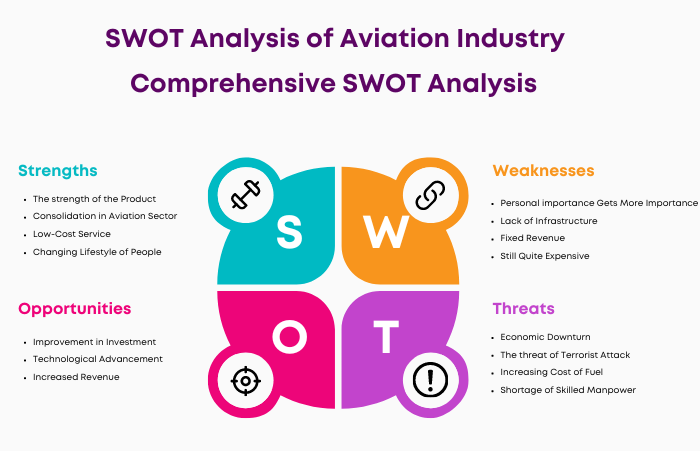Let’s explore the SWOT Analysis of Aviation Industry by understanding its strengths, weaknesses, opportunities, and threats.
Aviation industry means the entire aviation in India. Here, the industry can be divided into two major parts- civil aviation and military aviation. Among lots of other industries, the aviation industry is the fastest growing industry in India. The aviation manufacturing hub in India is located at Bangalore, and it constitutes around 65% share of manufacturing.
As the number of people, traveling by air, is increasing a lot, the prospect of the aviation industry is getting hiked. The amount of tax, paid by the Indian aviation sector, is more than INR 87.5 billion. The huge range of services, offered by the aviation industry in India includes cargo airlines, airport management, private jets and helicopters, maintenance, repair and overhaul, in-flight catering, ground handling and lots more.
Table of Contents
SWOT Analysis of Aviation Industry
Aviation Industry in India Strengths
The strengths of an industry or the businesses are mainly those things which make them unique in the market and also keep them far ahead of their competitors. The strong areas of the Indian Aviation Industry are as follows-
1. The strength of the Product– For every successful business, this is one of the most common objects that play a huge role in increasing the strength of the business. To the aviation industry in India, the product is air travel which is growing every day. The increased propensity to fly has provided immense growth to the industry while the huge population of the country plays the rest of the part.
2. Consolidation in Aviation Sector– the Indian aviation industry is growing because of the alliance it has got to promote its substantial growth.
3. Low-Cost Service– There are lots of airline services which are bringing the opportunity of flying at comparatively low cost than other plush airline services. Due to that, people try to fulfill their dream to fly.
4. Changing Lifestyle of People– Lifestyle of people is regularly changing, and the disposable income has also increased. This gives the opportunity of the enjoying the lavish way of traveling, flying.
5. The Labor Cost Is Low– in India, the labor cost is quite low, that is $30-35 per man for an hour. This is $55-60 in the Middle East and South-East Asia and even more in the USA and Europe.
6. When Safety Is Concerned– This is one of the safest modes to travel in comparison to others and also the quickest. People will prefer it more.
7. Highly Trained Staff– No matter the ground staff or the flight attendants, the Indian Aviation Industry is getting hyped because of the crew members of the industry.
8. Dealing with Advanced Technology– From fuel-efficient transport to the advanced and automated ground process, technological advancement has made this industry one of the fastest growing industries in the world.
Aviation Industry in India Weaknesses
Weaknesses mean these are the areas where the industry has scopes to do better than before. The places of improvement in this industry are-
1. Personal importance Gets More Importance– Each Airline Company deals with their own problems and concentrates only on their own issues instead of thinking about the entire industry of India.
2. Lack of Infrastructure– It is true that the Government is trying their best to get better-planned airports and top class infrastructure, still there are certain loopholes.
3. Fixed Revenue– This is a weakness of aviation industry in comparison to other transport industries. Actually, once the flight goes, the empty seat will remain empty.
4. Still Quite Expensive: No matter how the airline companies are providing cheap offers, still flight tickets are expensive and also require pricy disbursements.
Aviation Industry in India Opportunities
These are the areas which can be used to gain more revenues for the business. Some essential opportunities of this industry are as follows-
1. Improvement in Investment– For the green field airport the Government has approved 100% FDI of which 49% is for domestic airlines. Foreign investments up to 74% are permissible for direct investment.
2. Technological Advancement– The more technology will keep on blessing, the facilities like automated ground processes, fuel-efficient aircrafts, etc. are booming around.
3. Increased Revenue– The in-flight customer-friendly services have been increased, and the other value-added products will also raise the revenue as customers have to pay for those separately.
Aviation Industry in India Threats
These are the factors for a business which bring jeopardies for the industry and decline the growth of it. Some of the threats to aviation industry in India are-
1. Economic Downturn– A global economic slump can affect the growth of the aviation industry as it will disturb the leisure traveling along with business traveling.
2. The threat of Terrorist Attack– Seeing the situation of the world; this is always a great risk for the flights and overall aviation industry.
3. Increasing Cost of Fuel- Though fuel-efficient airlines are emerging, still maximum airlines are dependent on fuel. The cost is increasing which will inevitably make the flights more expensive.
4. Shortage of Skilled Manpower– This is a real trouble as skilled manpower like professional ground staffs, cabin crew, flight attendants, and pilots are not highly available.
Conclusion
Based on the SWOT analysis of the Indian aviation industry, it’s clear that this sector is poised for growth, driven by an increasing number of travelers, low labor costs, and advanced technology. However, challenges such as infrastructure gaps, high costs, and economic fluctuations remain. Opportunities like improved investment and technological advancements present significant potential for expansion. Despite threats like fuel costs and security concerns, the industry’s resilience and strategic efforts can lead to a promising future, making air travel more accessible and efficient for millions in India.
Liked this post? Check out the complete series on SWOT
